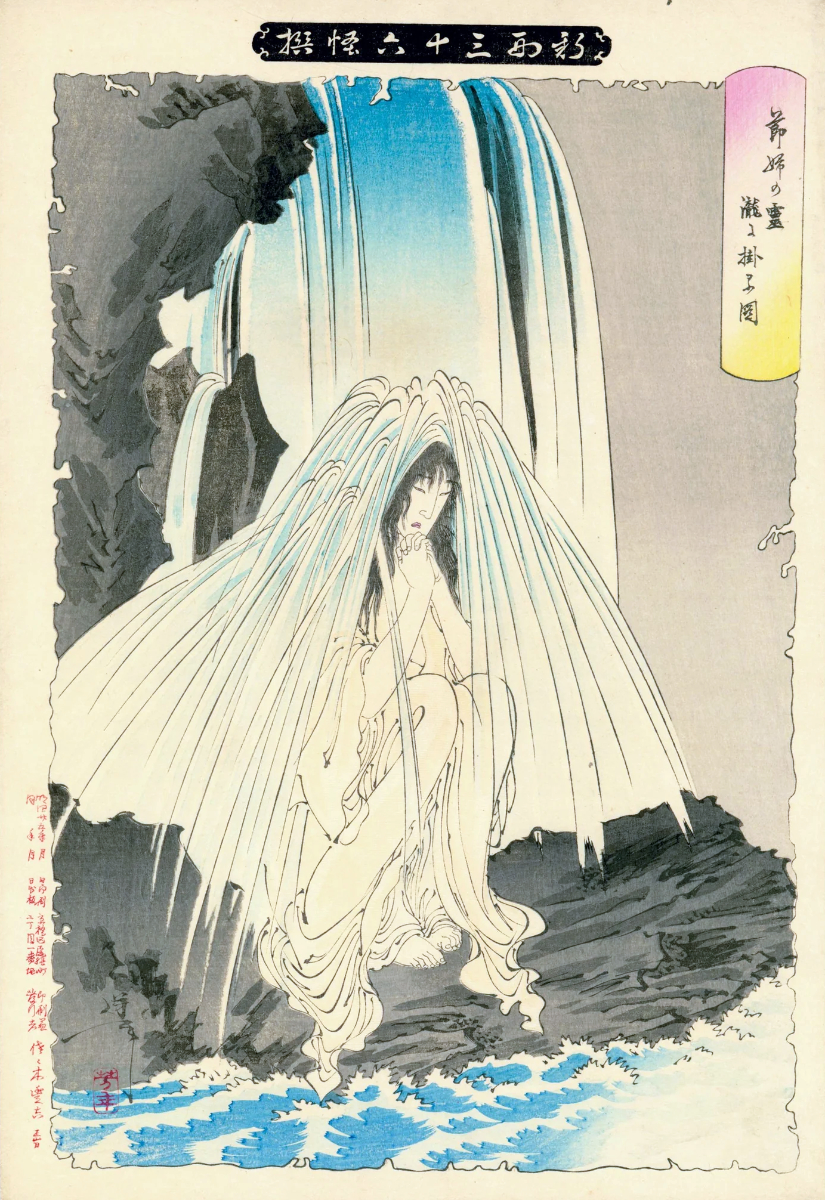In the Kabuki version of the story, Gentazaemon arranged for Botaro to be sent to a remote temple where he intended to have him killed. Botaro’s nurse, Otsuji, was aware of the danger but could do nothing to prevent it. For days she prayed fervently for his salvation to the god Kompira (an Indian deity incorporated into the Buddhist pantheon, eventually becoming a many-armed manifestation of the goddess Kannon). Finally Osaji killed herelf, praying that her life be accepted in exchange for Botaro’s The god listened, the boy was released the moment she died. Here we see Otsuji praying under a waterfall, on the principal that the discomfort of the cold water proves the sincerity of the supplicant and thus increases the efficacy of the prayers. From Yoshitoshi’s Thirty-Six Ghosts (1983) by John Stevenson.
| Alias Otsuji |
| Real Names/Alt Names Otsuji |
| Characteristics Hero, Myths & Legends, Scientific Revolution, Japanese |
| Creators/Key Contributors Tsukioka Yoshitoshi, ○ |
| First Appearance Osanago no Katakiuchi (A Child’s Revenge, 幼稚子敵討, 1753) by Namiki Shōzō I |
| First Publisher ○ |
| Appearance List Bunraku/kabuki: Osanago no Katakiuchi (A Child’s Revenge, 幼稚子敵討, 1753) by Namiki Shōzō I (with collaborators), Hana Ueno Homare no Ishibumi (Monument to the Glory of Ueno, 花上野誉石碑, 1788–1789) by Shimazō Shibaso, Tsutsui Hanji, Tankō Tazō, Tamaki Fudeni. Ukiyo-e: Tamiya Bōtarō no Hanashi (The Story of Tamiya Bōtarō, 新撰東錦絵:田宮坊太郎の話, 1886) by Tsukioka Yoshitoshi, Tamiya Bōtarō (Triptych, Story of Tamiya Bōtarō, 師範への敵討ち 三枚続, c.1847–1852) by Utagawa Kuniyoshi. |
| Sample Read Tsukioka Yoshitoshi at the Smithsonian National Museum of Asian Art [Smithsonian] |
| Description In the Kabuki version of the story, Gentazaemon arranged for Botaro to be sent to a remote temple where he intended to have him killed. Botaro’s nurse, Otsuji, was aware of the danger but could do nothing to prevent it. For days she prayed fervently for his salvation to the god Kompira (an Indian deity incorporated into the Buddhist pantheon, eventually becoming a many-armed manifestation of the goddess Kannon). Finally Osaji killed herelf, praying that her life be accepted in exchange for Botaro’s The god listened, the boy was released the moment she died. Here we see Otsuji praying under a waterfall, on the principal that the discomfort of the cold water proves the sincerity of the supplicant and thus increases the efficacy of the prayers. From Yoshitoshi’s Thirty-Six Ghosts (1983) by John Stevenson. |
| Source ○ |

